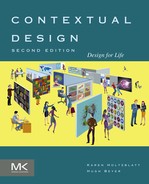Table of Contents
Design for life: the Cool Project
Immersion: tuning intuition and design thinking
You can’t just ask for design data
Deep insight comes from the field
Dealing with the data as a team
3. Principles of Contextual Inquiry
The four principles of Contextual Inquiry
The Contextual Interview structure
Building a shared understanding
5. From Data to Insight: Contextual Design Models
Graphical representations give the big picture
Consolidation thinking: induction
Design communication: using data to drive design
Building the Affinity as a team
Design communication and the Affinity Diagram
Part 3. Reinventing Life: Ideation with User Data
9. Inventing the Next Product Concept
People are part of the secret sauce
The challenge of design for life
A design process for invention
10. The Bridge From Data to Design: The Wall Walk
Making lists: creating a focus for creativity
Walking the Traditional Contextual Design Models
12. The Challenge of Product Design
Scenario versus structural reasoning
14. The User Environment Design
The User Environment Design elements
Building the User Environment Design from storyboards
The user interface and product structure
User Environment Design Walk-throughs
Innovation and interaction patterns
Building interaction patterns from the user environment design
Project planning and execution
18. Prioritization and Rollout
Partitioning a release for implementation
Driving concurrent implementation
19. Project Planning and Execution
Forming the cross-functional team
Determine the interviewing situation
